

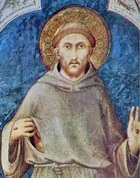
Detail of a fresco (early 14th century) attributed to Simone Martini
Cappella di San Martino, San Francesco, Assisi
The cult of St Francis was almost certainly the first cult to be stimulated in a major way by the use of visual imagery. The following works are particularly important for our understanding of this phenomenon.
Pescia Dossal (1235)
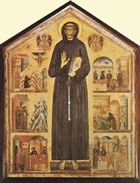
The example illustrated here is the only one of the surviving dossals that is dated: the inscription also identifies the artist, Bonaventura Berlinghieri. This dossal was painted for San Francesco, Pescia, and it is still in the church.
Bardi Dossal (ca. 1245)
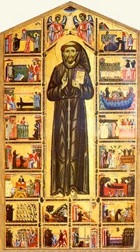
Vasari, attributed the dossal to Cimabue, but it is now generally attributed to the anonymous Master of the Bardi Dossal, who seems to have been active in Florence in the period 1240-70.
Christus Patiens (1236)
Brother Elias commissioned this crucifix, which was signed by Giunta Pisano and dated by inscription, for San Francesco, Assisi as the new church was approaching completion. Unfortunately, it was shattered beyond repair in ca. 1700. (The history of the crucifix is described in the page on Giunta Pisano).
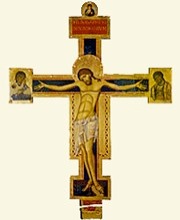

Christus patiens Christus patiens
from Santa Maria degli Angeli from San Domenico, Bologna
It is safe to assume that the crucifix in the upper church was similar to the two surviving crucifixes (illustrated above) that bear the signature of Giunta Pisano, both of which were painted for mendicant churches:
-
✴one of which was probably painted for Santa Maria degli Angeli, Assisi and is now in the Museo della Portiuncula, Assisi; while
-
✴ the other remains in San Domenico, Bologna.
These work represented the dying Christ in agony (Christus patiens), an iconography that was already established in Byzantine art.
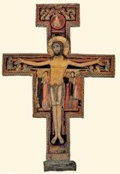
Brother Elias had served as Provincial Minister of Syria in 1217-20, and he may have introduced this Byzantine iconography to Italy. The use of this type of image in Franciscan churches was redolent of the devotion of St Francis to the crucified Christ, which culminated in his stigmatisation.
St Francis Dossal (ca. 1253)
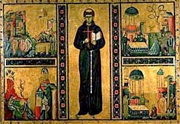
The work might well have been in place in the lower church when its high altar was consecrated in 1253 (see above). At least by the 16th century, it was believed to have been painted on the board on which the body of St Francis had been washed in preparation for burial, and it thus had the status of a relic. It may well have been placed close to the high altar above his burial chamber, and thus formed an integral part of his shrine.
St Francis (ca. 1255)
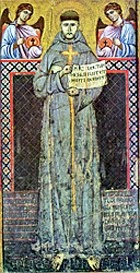
The long inscription in the lower part of the panel is taken from the bull “Confessor Domini gloriosus” (1237), in which Gregory IX defended the authenticity of the stigmata. However, the work itself probably celebrated the bull “Benigna operatio” (1255), in which Alexander IV specifically endorse the validity of St Francis’ side wound.
Frescoes in the Lower Church (ca. 1260-5)


These frescoes, which are attributed to the Maestro di San Francesco, are on opposite walls of the nave of the lower church of San Francesco. They depict:
-
✴scenes from the life of St Francis (on the left wall); and
-
✴scenes from the life of Christ.
This juxtaposition illustrates an emerging aspect of the cult of St Francis, his veneration as the “Alter Christus” (the other Christ). The frescoes would encourage pilgrims to meditate upon this as they approached the high altar over his tomb.
Frescoes of the Upper Church (late 13th century)
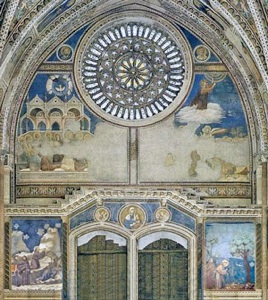
The frescoes on the lower part of the walls of the nave of the upper church of San Francesco, Assisi depict 28 scenes from the life of St Francis. The upper registers depict scenes from the Book of Genesis (on the left wall) and from the New Testament (on the right wall and on the counter-facade (illustrated above).
The inscriptions under the scenes from the life of St Francis are all taken from the related texts in the “Legenda Maior” (1260-3) by St Bonaventure, which became the “official” biography of St Francis in 1266. This cycle of frescoes in San Francesco, painted some thirty years later, became similarly canonical.
The sequence of the scenes is broadly chronological, and is read in a clockwise direction, starting from the junction of the nave and the right transept. However, the two scenes on the counter-facade are taken out of their chronological sequence:
-
✴On the left, as St Francis ascends to “a certain desert place”, he prays that water might be “brought forth from the rock” in order to provide for the needs of the poor man who had provided him with a mule for the journey.
-
✴On the right, St Francis preaches to the birds. These birds could represent the friars: according to Matthew 6:26, Christ said to the Apostles: “Consider the birds of the air: they neither sow nor reap nor gather into barns; and yet your heavenly Father feeds them”.
These scenes are probably meant to be read in conjunction with the scenes of from the New Testament above:
-
✴After the Ascension of Christ (above right), the Holy Spirit descended upon the Apostles (above left) and they were enabled to begin their evangelical missions.
-
✴In the scene on the lower left, St Francis, like Moses before him, produces water from the rock before ascending Fonte Colomba (the Franciscan Sinai) to receive the Franciscan Rule.
-
✴In the scene on the lower right, he passes it on to the friars so that they can preach the message of salvation.
Early Representations of St Francis in Rome
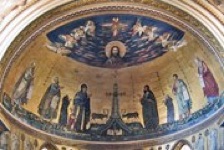
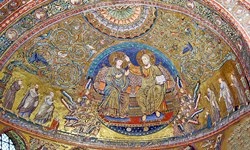
Pope Nicholas IV introduced figures of SS Francis and Antony of Padua into the mosaics that he commissioned for two of the most important Roman basilicas, and these probably represented their first appearances in non-Franciscan churches:
-
✴small figures of SS Francis and Antony appear alongside the Virgin and SS Peter, Paul John the Baptist, John the Evangelist and Andrew in the mosaic (1291) of the apse of San Giovanni Laterano (illustrated above, to the left); and
-
✴relatively larger figures of these saints appear with SS Peter, Paul, John the Baptist and John the Evangelist in the mosaic (1296) of the apse of Santa Maria Maggiore (illustrated above, to the right).
Both were the work of Jacopo Toritti, who also worked on some of the frescoes in the nave of the upper church of San Francesco.
Portiuncula Altarpiece (1393)
The perplexing history of the Portiuncula Indulgence has its own page on this site. It is sufficient here to note that the oral tradition that Honorius III granted this unprecedented and generous indulgence for those visiting the Portiuncula during what became known as the Festa del Perdono emerged in the late 1260s. It seems to have created an increase in the flow of pilgrims intent upon venerating St Francis at Assisi.







